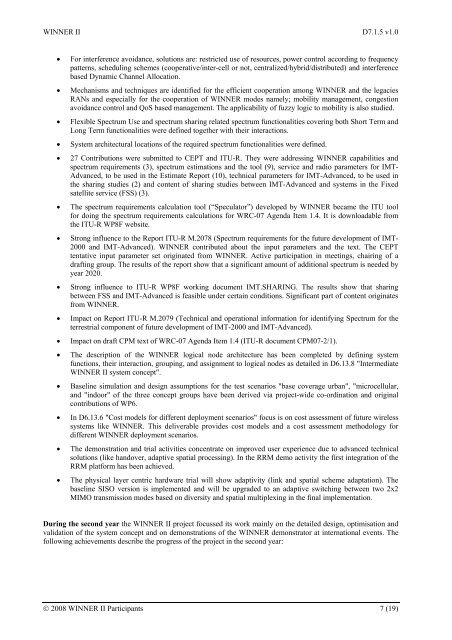IST-4-027756 WINNER II D7.1.5 v1.0 Final Report
IST-4-027756 WINNER II D7.1.5 v1.0 Final Report
IST-4-027756 WINNER II D7.1.5 v1.0 Final Report
You also want an ePaper? Increase the reach of your titles
YUMPU automatically turns print PDFs into web optimized ePapers that Google loves.
<strong>WINNER</strong> <strong>II</strong> <strong>D7.1.5</strong> <strong>v1.0</strong>• For interference avoidance, solutions are: restricted use of resources, power control according to frequencypatterns, scheduling schemes (cooperative/inter-cell or not, centralized/hybrid/distributed) and interferencebased Dynamic Channel Allocation.• Mechanisms and techniques are identified for the efficient cooperation among <strong>WINNER</strong> and the legaciesRANs and especially for the cooperation of <strong>WINNER</strong> modes namely; mobility management, congestionavoidance control and QoS based management. The applicability of fuzzy logic to mobility is also studied.• Flexible Spectrum Use and spectrum sharing related spectrum functionalities covering both Short Term andLong Term functionalities were defined together with their interactions.• System architectural locations of the required spectrum functionalities were defined.• 27 Contributions were submitted to CEPT and ITU-R. They were addressing <strong>WINNER</strong> capabilities andspectrum requirements (3), spectrum estimations and the tool (9), service and radio parameters for IMT-Advanced, to be used in the Estimate <strong>Report</strong> (10), technical parameters for IMT-Advanced, to be used inthe sharing studies (2) and content of sharing studies between IMT-Advanced and systems in the Fixedsatellite service (FSS) (3).• The spectrum requirements calculation tool (“Speculator”) developed by <strong>WINNER</strong> became the ITU toolfor doing the spectrum requirements calculations for WRC-07 Agenda Item 1.4. It is downloadable fromthe ITU-R WP8F website.• Strong influence to the <strong>Report</strong> ITU-R M.2078 (Spectrum requirements for the future development of IMT-2000 and IMT-Advanced). <strong>WINNER</strong> contributed about the input parameters and the text. The CEPTtentative input parameter set originated from <strong>WINNER</strong>. Active participation in meetings, chairing of adrafting group. The results of the report show that a significant amount of additional spectrum is needed byyear 2020.• Strong influence to ITU-R WP8F working document IMT.SHARING. The results show that sharingbetween FSS and IMT-Advanced is feasible under certain conditions. Significant part of content originatesfrom <strong>WINNER</strong>.• Impact on <strong>Report</strong> ITU-R M.2079 (Technical and operational information for identifying Spectrum for theterrestrial component of future development of IMT-2000 and IMT-Advanced).• Impact on draft CPM text of WRC-07 Agenda Item 1.4 (ITU-R document CPM07-2/1).• The description of the <strong>WINNER</strong> logical node architecture has been completed by defining systemfunctions, their interaction, grouping, and assignment to logical nodes as detailed in D6.13.8 "Intermediate<strong>WINNER</strong> <strong>II</strong> system concept".• Baseline simulation and design assumptions for the test scenarios "base coverage urban", "microcellular,and "indoor" of the three concept groups have been derived via project-wide co-ordination and originalcontributions of WP6.• In D6.13.6 "Cost models for different deployment scenarios" focus is on cost assessment of future wirelesssystems like <strong>WINNER</strong>. This deliverable provides cost models and a cost assessment methodology fordifferent <strong>WINNER</strong> deployment scenarios.• The demonstration and trial activities concentrate on improved user experience due to advanced technicalsolutions (like handover, adaptive spatial processing). In the RRM demo activity the first integration of theRRM platform has been achieved.• The physical layer centric hardware trial will show adaptivity (link and spatial scheme adaptation). Thebaseline SISO version is implemented and will be upgraded to an adaptive switching between two 2x2MIMO transmission modes based on diversity and spatial multiplexing in the final implementation.During the second year the <strong>WINNER</strong> <strong>II</strong> project focussed its work mainly on the detailed design, optimisation andvalidation of the system concept and on demonstrations of the <strong>WINNER</strong> demonstrator at international events. Thefollowing achievements describe the progress of the project in the second year:© 2008 <strong>WINNER</strong> <strong>II</strong> Participants 7 (19)
















